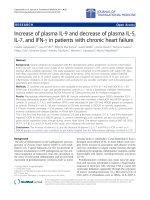Ebook Fluids and electrolytes made incredibly easy (6/E): Part 2
Bạn đang xem bản rút gọn của tài liệu. Xem và tải ngay bản đầy đủ của tài liệu tại đây (7.91 MB, 339 trang )
Chapter9
Whenphosphorustipsthebalance
Justthefacts
Inthischapter,you’lllearn:
♦
therolethatphosphorusplaysinthebody
♦
thebody’smechanismsforregulatingphosphorus
♦
waystoassessapatientforaphosphorusimbalance
♦
managementofhypophosphatemiaandhyperphosphatemia.
Alookatphosphorus
Phosphorusistheprimaryanion,ornegativelychargedion,foundinintracellularfluid.It’s
containedinthebodyasphosphate.(Thetwowords—phosphorusandphosphate—are
commonlyusedinterchangeably.)About85%ofphosphorusexistsinboneandteeth,combinedin
a1:2ratiowithcalcium.About14%isinsofttissue,andlessthan1%isinextracellularfluid.
Whyit’simportant
Anessentialelementofallbodytissues,phosphorusisvitaltovariousbodyfunctions.Itplaysa
crucialroleincellmembraneintegrity(phospholipidsmakeupthecellmembranes);muscle
function;neurologicfunction;andthemetabolismofcarbohydrates,fat,andprotein.Phosphorusis
aprimaryingredientin2,3-diphosphoglycerate(2,3-DPG),acompoundinredbloodcells
(RBCs)thatpromotesoxygendeliveryfromRBCstothetissues.
Phosphorusalsohelpsbufferacidsandbases.Itpromotesenergytransfertocellsthroughthe
formationofenergy-storingsubstancessuchasadenosinetriphosphate(ATP).It’salsoimportant
forwhitebloodcell(WBC)phagocytosisandforplateletfunction.Finally,withcalcium,
phosphorusisessentialforhealthybonesandteeth.
Thelowdownonlowphosphoruslevels
Normalserumphosphoruslevelsinadultsrangefrom2.5to4.5mg/dl(or1.8to2.6mEq/L).In
comparison,thenormalphosphoruslevelinthecellsis100mEq/L.Becausephosphorusis
locatedprimarilywithinthecells,serumlevelsmaynotalwaysreflectthetotalamountof
phosphorusinthebody.Forexample,it’simportanttodistinguishbetweenadecreaseinthelevel
ofserumphosphate(hypophosphatemia)andadecreaseintotalbodystorageofphosphate
(phosphatedeficiency).
Howthebodyregulatesphosphorus
Thetotalamountofphosphorusinthebodyisrelatedtodietaryintake,hormonalregulation,
kidneyexcretion,andtranscellularshifts.Foradults,therangefortherecommendeddaily
requirementofphosphorusis800to1,200mg.Phosphorusisreadilyabsorbedthroughthe
gastrointestinal(GI)tract,withtheamountabsorbedproportionaltotheamountingested.(See
Dietarysourcesofphosphorus.)
Dietarysourcesofphosphorus
Majordietarysourcesofphosphorusinclude:
•
dairyproducts,suchasmilkandcheese
•
driedbeans
•
eggs
•
fish
•
nutsandseeds
•
organmeats,suchasbrainandliver
•
poultry
•
wholegrains(Shutoetal.,2009)
Mostingestedphosphorusisabsorbedthroughthejejunum.Thekidneysexcreteabout90%of
phosphorusastheyregulateserumlevels.(TheGItractexcretestherest.)Ifdietaryintakeof
phosphorusincreases,thekidneysincreaseexcretiontomaintainnormallevelsofphosphorus.A
low-phosphorusdietcausesthekidneystoconservephosphorusbyreabsorbingmoreofitinthe
proximaltubules.
BalancingitoutwithPTH
Theparathyroidglandcontrolshormonalregulationofphosphoruslevelsbyaffectingtheactivity
ofparathyroidhormone(PTH).(SeePTHandphosphorus.)Changesincalciumlevels,rather
thanchangesinphosphoruslevels,affectthereleaseofPTH.Youmayrecallthatphosphorus
balanceiscloselyrelatedtocalciumbalance.
PTHandphosphorus
ThisillustrationshowshowPTHaffectsserumphosphorus(P)levelsbyincreasingphosphorus
releasefrombone,increasingphosphorusabsorptionfromtheintestines,anddecreasingphosphorus
reabsorptionintherenaltubules.
Normally,calciumandphosphorushaveaninverserelationship.Forinstance,whentheserum
calciumlevelislow,thephosphoruslevelishigh.Thiscausestheparathyroidglandtorelease
PTH,whichcausesanincreaseincalciumandphosphorusresorptionfrombone,raisingboth
calciumandphosphoruslevels.Phosphorusabsorptionfromtheintestinesalsoincreases.
(ActivatedvitaminD—calcitriol—alsoenhancesphosphorusabsorptionintheintestines.)
Kidneysentertheequation
PTHalsoactsonthekidneystoincreaseexcretionofphosphorus.TherenaleffectofPTH
outweighsitsothereffectsontheserumphosphoruslevel,particularlythatofreturningthe
phosphorusleveltonormal.ReducedPTHlevelsallowforphosphorusreabsorptionbythe
kidneys.Asaresult,serumlevelsrise(Connor,2009).
Shiftybusiness
Certainconditionscausephosphorustomove,orshift,inandoutofcells.Insulinmovesnotonly
glucosebutalsophosphorusintothecell.Alkalosisresultsinthesamekindofphosphorusshift.
Thoseshiftsaffectserumphosphoruslevels.(SeeElderlypatientsatrisk,page170.)
Agesandstages
Elderlypatientsatrisk
Elderlypatientsareparticularlyatriskforalteredelectrolytelevelsfortwomainreasons.First,they
havealowerratioofleanbodyweighttototalbodyweight,whichplacesthematriskforwater
deficit.Second,theirthirstresponseisdiminishedandtheirrenalfunctiondecreased,whichmakes
maintainingelectrolytebalancemoredifficult.Age-relatedrenalchangesincludechangesinrenal
bloodflowandglomerularfiltrationrate.
Medicationscanalsoalterelectrolytelevelsbyaffectingtheabsorptionofphosphate.Somakesure
youaskelderlypatientsifthey’reusingsuchover-the-countermedicationsasantacids,laxatives,
herbs,andteas.
Hypophosphatemia
Hypophosphatemiaoccurswhentheserumphosphoruslevelfallsbelow2.5mg/dl(or1.8
mEq/L).Althoughthisconditiongenerallyindicatesadeficiencyofphosphorus,itcanoccur
undervariouscircumstanceswhentotalbodyphosphorusstoresarenormal.Severe
hypophosphatemiaoccurswhenserumphosphoruslevelsarelessthan1mg/dlandthebody
can’tsupportitsenergyneeds.Theconditionmayleadtoorganfailure.
Howithappens
Threeunderlyingmechanismscanleadtohypophosphatemia:ashiftofphosphorusfrom
extracellularfluidtointracellularfluid,adecreaseinintestinalabsorptionofphosphorus,andan
increasedlossofphosphorusthroughthekidneys.Somecausesofhypophosphatemiamayinvolve
morethanonemechanism.
Severalfactorsmaycausephosphorustoshiftfromextracellularfluidintothecell.Herearethe
mostcommoncauses.
Whenhyperventilationhappens
Respiratoryalkalosis,oneofthemostcommoncausesofhypophosphatemia,canstemfroma
numberofconditionsthatproducehyperventilation,includingsepsis,alcoholwithdrawal,heat
stroke,pain,anxiety,diabeticketoacidosis,hepaticencephalopathy,andacutesalicylate
poisoning.Althoughthemechanismthatpromptsrespiratoryalkalosistoinducehypophosphatemia
isunknown,theresponseisashiftofphosphorusintothecellsandaresultingdecreaseinserum
phosphoruslevels.
Sugarhigh
Hyperglycemia,anelevatedserumglucoselevel,causesthereleaseofinsulin,whichtransports
glucoseandphosphorusintothecells.Thesameeffectmayoccurinapatientwithdiabeteswho’s
receivinginsulinorinasignificantlymalnourishedpatient;atparticularriskformalnourishment
areelderly,debilitated,oralcoholicpatientsandthosewithanorexianervosa.
Failuretoaddphosphorus
Afterinitiationofenteralorparenteralfeedingwithoutsufficientphosphorussupplementation,
phosphorusshiftsintothecells.Thisshift—calledrefeedingsyndrome—usuallyoccurs3ormore
daysafterfeedingsbegin.Patientsrecoveringfromhypothermiacanalsodevelop
hypophosphatemiaasphosphorusmovesintothecells.
Abnormalabsorption
Malabsorptionsyndromes,starvation,andprolongedorexcessiveuseofphosphorus-binding
antacidsorsucralfateareamongthemanycausesofimpairedintestinalabsorptionofphosphorus.
BecausevitaminDcontributestointestinalabsorptionofphosphorus,inadequatevitaminDintake
orsynthesiscaninhibitphosphorusabsorption.Chronicdiarrheaorlaxativeabusecanalsoresult
inincreasedGIlossofphosphorus.Decreaseddietaryintakerarelycauseshypophosphatemia
becausephosphateisfoundinmostfoods.
Callingthekidneystoaccount
Diureticuseisthemostcommoncauseofphosphoruslossthroughthekidneys.Thiazides,loop
diuretics,andacetazolamidearethediureticsthatmostcommonlycausehypophosphatemia.(See
Drugsassociatedwithhypophosphatemia.)
Drugsassociatedwithhypophosphatemia
Thefollowingdrugsarecommonlyassociatedwithhypophosphatemia:
•
acetazolamide,thiazidediuretics(chlorothiazideandhydrochlorothiazide),loopdiuretics
(bumetanideandfurosemide),andotherdiuretics
•
antacids,suchasaluminumcarbonate,aluminumhydroxide,calciumcarbonate,andmagnesiumoxide
•
insulin
•
laxatives.
Thesecondmostcommoncauseisdiabeticketoacidosis(DKA)indiabeticpatientswhohave
poorlycontrolledbloodglucoselevels.InDKA,highglucoselevelsinduceanosmoticdiuresis.
Thisresultsinasignificantlossofphosphorusfromthekidneys.Ethanolaffectsphosphorus
reabsorptioninthekidneyssothatmorephosphorusisexcretedinurine.
AbuildupofPTH,whichoccurswithhyperparathyroidismandhypocalcemia,alsoleadsto
hypophosphatemiabecausePTHstimulatesthekidneystoexcretephosphate.Finally,
hypophosphatemiaoccursinpatientswhohaveextensiveburns.Althoughthemechanismis
unclear,theconditionseemstooccurinresponsetotheextensivediuresisofsaltandwaterthat
typicallyoccursduringthefirst2to4daysafteraburninjury.Respiratoryalkalosisand
carbohydrateadministrationmayalsoplayarolehere.
Whattolookfor
Mildtomoderatehypophosphatemiadoesn’tusuallycausesymptoms.Noticeableeffectsof
hypophosphatemiatypicallyoccuronlyinseverecases.Thecharacteristicsofsevere
hypophosphatemiaareapparentinmanyorgansystems.Signsandsymptomsmaydevelopacutely
becauseofrapiddecreasesinphosphorusorgraduallyastheresultofslow,chronicdecreasesin
phosphorus.
Hypophosphatemiaaffectsthemusculoskeletal,centralnervous,cardiac,andhematologic
systems.Becausephosphorusisrequiredtomakehigh-energyATP,manyofthesignsand
symptomsofhypophosphatemiaarerelatedtolowenergystores.
Weakandweary
Withhypophosphatemia,muscleweaknessisthemostcommonsymptom.Othersymptomsmay
includediplopia(doublevision),malaise,andanorexia.Thepatientmayexperienceaweakened
handgrasp,slurredspeech,ordysphagia.Healsomaydevelopmyalgia(tendernessorpaininthe
muscles).
Respiratoryfailuremayresultfromweakenedrespiratorymusclesandpoorcontractilityofthe
diaphragm.Respirationsmayappearshallowandineffective.Inlaterstages,thepatientmaybe
cyanotic.Keepinmindthatitmaybedifficulttoweanamechanicallyventilatedpatientwith
hypophosphatemiafromtheventilator.
Withseverehypophosphatemia,rhabdomyolysis(skeletalmuscledestruction)canoccurwith
alteredmusclecellactivity.Muscleenzymessuchascreatinekinasearereleasedfromthecells
intotheextracellularfluid.Lossofbonedensity,osteomalacia(softeningofthebones),andbone
painmayalsooccurwithprolongedhypophosphatemia.Fracturescanresult.
Logicalneurologiceffects
Withoutenoughphosphorus,thebodycan’tmakeenoughATP,acornerstoneofenergymetabolism.
Asaresult,centralnervoussystemcellscanmalfunction,causingparesthesia,irritability,
apprehension,memoryloss,andconfusion.Theneurologiceffectsofhypophosphatemiamay
progresstoseizuresorcoma.
Whentheheartisn’thardy
Theheart’scontractilitydecreasesbecauseoflowenergystoresofATP.Asaresult,thepatient
maydevelophypotensionandlowcardiacoutput.Severehypophosphatemiamayleadto
cardiomyopathy,whichtreatmentcanreverse.
Oxygendeliverydrop-off
Adropinproductionof2,3-DPGcausesadecreaseinoxygendeliverytotissues.Because
hemoglobinhasastrongeraffinityforoxygenthanforothergases,oxygenislesslikelytobegiven
uptothetissuesasitcirculatesthroughthebody.Asaresult,lessoxygenisdeliveredtothe
myocardium,whichcancausechestpain.
Hypophosphatemiamayalsocausehemolyticanemiabecauseofchangesinthestructureand
functionofRBCs.Patientswithhypophosphatemiaaremoresusceptibletoinfectionbecauseof
theeffectoflowlevelsofATPinWBCs.LackofATPresultsinadecreasedfunctioningof
leukocytes.Chronichypophosphatemiaalsoaffectsplateletfunction,resultinginbruisingand
bleeding,particularlymildGIbleeding.
Whattestsshow
Thesediagnostictestresultsmayindicatehypophosphatemiaorarelatedcondition:
•serumphosphorusleveloflessthan2.5mg/dl(or1.8mEq/L);severehypophosphatemia,less
than1mg/dl
•elevatedcreatinekinaselevelifrhabdomyolysisispresent
•X-raystudiesthatrevealtheskeletalchangestypicalofosteomalaciaorbonefractures
•abnormalelectrolytes(decreasedmagnesiumlevelsandincreasedcalciumlevels).
Howit’streated
Treatmentvarieswiththeseverityandcauseofthecondition.Itincludestreatingtheunderlying
causeandcorrectingtheimbalancewithphosphorusreplacementandahigh-phosphorusdiet.The
routeofreplacementtherapydependsontheseverityoftheimbalance.
Mildermeasures
Treatmentformildtomoderatehypophosphatemiaincludesadiethighinphosphorus-richfoods,
suchaseggs,nuts,wholegrains,organmeats,fish,poultry,andmilkproducts.However,if
calciumiscontraindicatedorthepatientcan’ttoleratemilk,heshouldinsteadreceiveoral
phosphorussupplements.OralsupplementsincludeNeutra-PhosandNeutra-Phos-Kandcanbe
usedformoderatehypophosphatemia.Dosagelimitationsarerelatedtotheadverseeffects,most
notablynauseaanddiarrhea.(SeeWhendietarychangesaren’tworking.)
It’snotworking
Whendietarychangesaren’tworking
Ifyourpatient’sphosphorus-richdiethasn’traisedserumphosphoruslevelsasyouhadhoped,it’s
timetoaskthesequestions:
•
IsaGIproblemmakingphosphorusdigestiondifficult?
•
Isyourpatientusingaphosphate-bindingantacid?
•
Isyourpatientabusingalcohol?
•
Isyourpatientusingathiazidediuretic?
•
Isyourpatientcomplyingwiththetreatmentregimenfordiabetes?
Sternersteps
ForpatientswithseverehypophosphatemiaoranonfunctioningGItract,I.V.phosphorus
replacementistherecommendedchoice.Twopreparationsareused:I.V.potassiumphosphateand
I.V.sodiumphosphate.Dosageisguidedbythepatient’sresponsetotreatmentandserum
phosphoruslevels.
Potassiumphosphaterequiresslowadministration(nomorethan10mEq/hour).Adverse
effectsofI.V.replacementforhypophosphatemiaincludehyperphosphatemiaandhypocalcemia.
Howyouintervene
Ifyourpatientbeginstotalparenteralnutritionorisotherwiseatriskfordeveloping
hypophosphatemia,monitorhimforsignsandsymptomsofthisimbalance.Ifthepatienthas
alreadydevelopedhypophosphatemia,yournursingcareshouldfocusoncarefulmonitoring,
safetymeasures,andinterventionstorestorenormalserumphosphoruslevels.(SeeTeaching
abouthypophosphatemia.)Alertthepractitionertoanychangesinthepatient’sconditionandtake
theseotheractions:
Teachingpoints
Teachingabouthypophosphatemia
Whenteachingapatientwithhypophosphatemia,besuretocoverthefollowingtopicsandthen
evaluateyourpatient’slearning:
•
descriptionofhypophosphatemiaanditsriskfactors,prevention,andtreatment
•
medicationsordered
•
needtoconsultwithadietitian
•
needforahigh-phosphorusdiet(1qtofcow’smilkperdayprovidestheaverageamountof
phosphaterequired)
•
avoidanceofphosphate-bindingantacids
•
warningsignsandsymptomsandwhentoreportthem
•
needtomaintainfollow-upappointments.
•Monitorvitalsigns.Remember,hypophosphatemiacanleadtorespiratoryfailure,lowcardiac
output,confusion,seizures,orcoma.
•Assessthepatient’slevelofconsciousnessandneurologicstatuseachtimeyoucheckhisvital
signs.Documentyourobservationsandthepatient’sneurologicstatusonaflowsheetso
changescanbenotedimmediately.(SeeDocumentinghypophosphatemia.)
Chartsmart
Documentinghypophosphatemia
Ifyourpatienthashypophosphatemia,makesureyoudocumentthefollowinginformation:
•
vitalsigns
•
neurologicstatus,includinglevelofconsciousness,restlessness,andapprehension
•
musclestrength
•
respiratoryassessment
•
serumelectrolytelevelsandotherpertinentlaboratorydata
•
notificationofthepractitioner
•
I.V.therapy,includingconditionofI.V.site,medication,dose,andthepatient’sresponse
•
seizures,ifany
•
yourinterventionsandthepatient’sresponse
•
safetymeasurestoprotectthepatient
•
patientteaching.
•Monitortherateanddepthofrespirations,especiallyifthepatienthassevere
hypophosphatemia.Reportsignsofhypoxia,suchasconfusion,restlessness,increased
respiratoryrateand,inlaterstages,cyanosis.Ifpossible,takestepstopreventhyperventilation
becauseitworsensrespiratoryalkalosisandcanlowerphosphoruslevels.Followarterial
bloodgasresultsandpulseoximetrylevelstomonitortheeffectivenessofventilation.Ifthe
patientisonaventilator,weanhimoffslowly.
•Monitorthepatientforevidenceofheartfailurerelatedtoreducedmyocardialfunctioning.
Signsandsymptomsincludecrackles,shortnessofbreath,decreasedbloodpressure,and
elevatedheartrate.
•Monitorthepatient’stemperatureatleastevery4hours.CheckWBCcounts.Followstrict
steriletechniqueinchangingdressings.Reportsignsofinfection.
•Assessthepatientfrequentlyforevidenceofdecreasingmusclestrength,suchasweakhand
graspsorslurredspeech,anddocumentyourfindingsregularly.
•Administerprescribedphosphorussupplements.Keepinmindthatoralsupplementsmaycause
diarrhea.Toimprovetheirtaste,mixthemwithjuice.VitaminDmayalsobeorderedwiththe
oralphosphatesupplementstoincreaseabsorption.
•InsertanI.V.lineasordered,andkeepitpatent.Infusephosphorussolutionsslowlyusingan
infusiondevicetocontroltherate.Duringinfusions,watchforsignsofhypocalcemia,
hyperphosphatemia,andI.V.infiltration;potassiumphosphatecancausetissuesloughingand
necrosis.Monitorserumphosphatelevelsevery6hours.
•Administerananalgesic,ifordered.
•Ifordered,makesurethepatientmaintainsbedrestforsafety.Keepthebedinitslowest
position,withthewheelslockedandthesiderailsraised.Ifthepatientisatriskforseizures,
padthesiderailsandkeepanartificialairwayatthepatient’sbedside.
•Orientthepatientasneeded.Keepclocks,calendars,andfamiliarpersonalobjectswithinhis
sight.
•Informthepatientandhisfamilythatconfusioncausedbyalowphosphoruslevelisonly
temporaryandwilllikelydecreasewiththerapy.
•Recordthepatient’sfluidintakeandoutput.
•Closelymonitorserumelectrolytelevels,especiallycalciumandphosphoruslevels,aswellas
otherpertinentlaboratorytestresults.Reportabnormalities.
•Assistthepatientwithambulationandactivitiesofdailyliving,ifneeded,andkeepessential
objectsnearthepatienttopreventaccidents.
Hyperphosphatemia
Hyperphosphatemiaoccurswhenserumphosphoruslevelsexceed4.5mg/dl(or2.6mEq/L)
andusuallyreflectsthekidneys’inabilitytoexcreteexcessphosphorus.Thecondition
commonlyoccursalongwithanincreasedreleaseofphosphorusfromdamagedcells.
Severehyperphosphatemiaoccurswhentheserumphosphoruslevelsreach6mg/dlor
higher.
Howithappens
Hyperphosphatemiacanresultfromanumberofunderlyingmechanisms,includingimpairedrenal
excretionofphosphorus,ashiftofphosphorusfromtheintracellularfluidtotheextracellular
fluid,andanincreaseindietaryintakeofphosphorus.
Kidneyfilterfailure
Normally,renalexcretionofphosphorusequalstheamounttheGItractabsorbsdaily.
Hyperphosphatemiamostcommonlyresultsfromrenalfailureduetothekidneys’inabilityto
excreteexcessphosphorus.
Whenglomerularfiltrationratedropsbelow30ml/minute,thekidneyscan’tfilterexcess
phosphorusadequately.Becausethekidneysareresponsibleformostoftheexcretionof
phosphorus,theirinabilitytofilterphosphorusleadstoanelevatedserumphosphoruslevel
(Spaia,2011).
PTHproblem
Ariskafterthyroidorparathyroidsurgery,hypoparathyroidismimpairssynthesisofPTH.When
lessPTHissynthesized,lessphosphorusisexcretedfromthekidneys.Theresult?Elevatedserum
phosphoruslevels.
Shiftwork
Severalconditionscancausephosphorustoshiftfromtheintracellularfluidtotheextracellular
fluid.Acid-baseimbalances,suchasrespiratoryacidosisandDKA,arecommonexamples.
Anythingthatcausescellulardestructioncanalsoresultinatranscellularshiftofphosphorus.
Destructionofcellscantriggerthereleaseofintracellularphosphorusintoextracellularfluid,
causingserumphosphoruslevelstorise.Chemotherapy,forexample,causessignificantcell
destruction,asdomusclenecrosisandrhabdomyolysis,conditionsthatcanstemfrominfection,
heatstroke,andtrauma.
Increasedintake
Excessiveintakeofphosphoruscanresultfromoveradministrationofphosphorussupplementsor
oflaxativesorenemasthatcontainphosphorus(suchasFleetenemas).(SeeDrugsassociated
withhyperphosphatemia.)
Drugsassociatedwithhyperphosphatemia
Thefollowingdrugsmaycausehyperphosphatemia:
•
enemassuchasFleetenemas
•
laxativescontainingphosphorusorphosphate
•
oralphosphorussupplements(Neutra-Phos)
•
parenteralphosphorussupplements(sodiumphosphate,potassiumphosphate)
•
vitaminDsupplements.
Ininfants,excessiveintakeofvitaminDcanresultinincreasedabsorptionofphosphorusand
leadtoelevatedserumphosphoruslevels.(SeeCow’smilkandhyperphosphatemia.)
Agesandstages
Cow’smilkandhyperphosphatemia
Infantswhoarefedcow’smilkarepredisposedtohyperphosphatemiabecausecow’smilkcontains
morephosphorusthanbreastmilk.Inaddition,infantshavenaturallyhighphosphoruslevels.
Whattolookfor
Hyperphosphatemiacausesfewclinicalproblemsbyitself.However,phosphorusandcalcium
levelshaveaninverserelationship:Ifoneishigh,theotherislow.Becauseofthisseesaw
relationship,hyperphosphatemiamayleadtohypocalcemia,whichcanbelife-threatening.Signs
andsymptomsofacutehyperphosphatemiaareusuallycausedbytheeffectsofhypocalcemia.
Memoryjogger
Toremembersomeofthesignsandsymptomsofhyperphosphatemia,thinkofthewordCHEMO
(keepinginmindthatchemotherapycanleadtohyperphosphatemia):
Cardiacirregularities
Hyperreflexia
Eatingpoorly
Muscleweakness
Oliguria.
Thepatientmaydevelopparesthesiainthefingertipsandaroundthemouth,whichmayincrease
inseverityandspreadproximallyalongthelimbsandtotheface.Severemusclespasm,cramps,
pain,andweaknessmaypreventthepatientfromperformingnormalactivities.Thepatientmay
exhibithyperreflexiaandpositiveChvostek’sandTrousseau’ssigns.Thesesignsareduetolow
calciumlevelsandmayprogresstotetanyandneurologicdisorders.
Neurologicsignsandsymptomsincludedecreasedmentalstatus,delirium,andseizures.
Electrocardiogram(ECG)changesincludeaprolongedQTintervalandSTsegment.Thepatient
mayalsoexperiencehypotension,heartfailure,anorexia,nausea,andvomiting.Bonedevelopment
mayalsobeaffected.
Calcificationcues
Whenphosphoruslevelsrise,phosphorusbindswithcalcium,forminganinsolublecompound
calledcalciumphosphate.Organdysfunctioncanresultwhencalciumphosphateprecipitates,or
isdeposited,intheheart,lungs,kidneys,orothersofttissues.Thisprocess,calledcalcification,
usuallyoccursasaresultofchronicallyelevatedphosphoruslevels.(SeeAlookatcalcification,
page178.)
Alookatcalcification
Whenserumphosphoruslevelsarehigh,phosphorusbindswithcalciumtoformaninsoluble
compoundcalledcalciumphosphate.Thecompoundisdepositedintheheart,lungs,kidneys,eyes,
skin,andothersofttissueswhereitinterfereswithnormalorganandtissuefunction.Thisillustration
showssomeoftheorgansaffectedandtheeffectcalcificationhasontheseorgans.
Withcalcification,thepatientmayexperiencearrhythmias,anirregularheartrate,and
decreasedurineoutput.Cornealhaziness,conjunctivitis,cataracts,andimpairedvisionmay
occur,andpapulareruptionsmaydevelopontheskin.
Whattestsshow
Thefollowingdiagnostictestsresultsmayindicatehyperphosphatemiaorarelatedconditionsuch
ashypocalcemia:
•serumphosphoruslevelabove4.5mg/dl(or2.6mEq/L)
•serumcalciumlevelbelow8.5mg/dl
•X-raystudiesthatrevealskeletalchangesduetoosteodystrophy(defectivebonedevelopment)
inchronichyperphosphatemia
•increasedbloodureanitrogen(BUN)andcreatininelevels,whichreflectworseningrenal
function
•ECGchangescharacteristicofhypocalcemia(suchasaprolongedQTinterval).
Howit’streated
Anelevatedserumphosphoruslevelmaybetreatedwithdrugsandothertherapeuticmeasures.
Treatmentaimstocorrecttheunderlyingdisorder,ifoneexists,andcorrecthypocalcemia.
Goinglowphospho
Ifapatient’selevatedserumphosphoruslevelresultsfromexcessivephosphorusintake,the
conditionmaybeeasilyremediedbyreducingphosphorusintake.Therapeuticmeasuresinclude
reducingdietaryintakeofphosphorusandeliminatingtheuseofphosphorus-basedlaxativesand
enemas.(SeeWhendietarychangesaren’tenough.)
It’snotworking
Whendietarychangesaren’tenough
Ifyourpatient’slow-phosphorusdiethasn’tchangedhisserumphosphoruslevel,it’stimetoaskthese
questions:
•
Isthepatienttakingmedications(suchasphosphorus-bindingantacids)asdirected?
•
Isthepatientcontinuingtouselaxativesorenemasthatcontainphosphate?
•
Arethepatient’skidneysfunctioning?
•
Hastheunderlyingcauseofhyperphosphatemiabeencorrected?
Alteringabsorption
DrugtherapymayhelpdecreaseabsorptionofphosphorusintheGIsystem.Suchtherapymay
includealuminum,magnesium,orcalciumgelorphosphate-bindingantacids.Althoughwidely
used,suchcalciumsaltsascalciumcarbonateandcalciumacetatemaycausehypercalcemia,so
thepatientwillneedcarefuldosing.Polymericphosphatebinderssuchassevelamer
hydrochloridemayalsobegiven.Apatientwithunderlyingrenalinsufficiencyorrenalfailure
shouldnotreceivemagnesiumantacidsbecausetheymaycausehypermagnesemia.Apatientwith
end-stagerenaldiseasemayreceivelanthanumcarbonate,anoncalcium,nonaluminumphosphate
binder.
Keepinmindthatamildlyelevatedphosphoruslevelmaybenefitapatientwithrenalfailure.
Higherphosphoruslevels(onthehighersideofthenormalrange)allowmoreoxygentomove
fromtheRBCstotissues,whichcanhelppreventhypoxemiaandlimittheeffectsofchronic
anemiaonoxygendelivery.
Treatwhat’sunderneath
Treatmentoftheunderlyingcauseofhyperphosphatemia,includingconditionssuchasrespiratory
acidosisorDKA,canlowerserumphosphoruslevels.Inapatientwithdiabetes,administering
insulincausesphosphorustoshiftbackintothecells,whichcanresultindecreasedserum
phosphoruslevels.
Situation:severe
PatientswithseverehyperphosphatemiamayreceiveI.V.salinesolutiontopromoterenal
excretionofphosphorus.However,thistreatmentrequiresthepatienttohavefunctionalkidneys
andtheabilitytotoleratetheincreasedloadofsodiumandfluid.Patientsmayalsoreceive
proximaldiureticssuchasacetazolamidetoincreaserenalexcretionofphosphorus.
Asafinaltherapeuticintervention,hemodialysisorperitonealdialysismaybeinitiatedifthe
patienthaschronicrenalfailureoranextremecaseofacutehyperphosphatemiawithsymptomatic
hypocalcemia.
Howyouintervene
Keepaneyeoutforpatientsatriskforhyperphosphatemia,andmonitorthemcarefully.Also,use
carewhenadministeringphosphorusinI.V.infusions,enemas,andlaxativesbecausetheextra
phosphorusmaycausehyperphosphatemia.
Ifyourpatienthasalreadydevelopedhyperphosphatemia,yourcareshouldfocusoncareful
monitoring,safetymeasures,andinterventionstorestorenormalserumphosphoruslevels.Follow
thesestepstoprovidecareforthepatient:
•Monitorvitalsigns.
•Watchforsignsandsymptomsofhypocalcemia,suchasparesthesiainthefingersoraroundthe
mouth,hyperactivereflexes,ormusclecramps.Ifanyoftheseoccur,immediatelynotifythe
doctor.(SeeTeachingabouthyperphosphatemia.)Alsonotifythepractitionerifyoudetect
signsorsymptomsofcalcification,includingoliguria,visualimpairment,conjunctivitis,
irregularheartrateorpalpitations,andpapulareruptions.
Teachingpoints
Teachingabouthyperphosphatemia
Whenteachingapatientwithhyperphosphatemia,besuretocoverthefollowingtopicsandthen
evaluateyourpatient’slearning:
•
causesandtreatment
•
prescribedmedications
•
avoidanceofpreparationsthatcontainphosphorus,suchaslaxatives,enemas,andsupplements
•
avoidanceofhigh-phosphorusfoods,suchasdairyproducts,organmeats,fish,poultry,eggs,andnuts
andseeds
•
warningsignsandsymptoms
•
referralstoadietitianandsocialservices,ifindicated.
•Monitorfluidintakeandoutput.Ifurineoutputfallsbelow30ml/hour,immediatelynotifythe
practitioner.Decreasedurineoutputcanseriouslyaffectrenalclearanceofexcessserum
phosphorus.
•Closelymonitorserumelectrolytelevels,especiallycalciumandphosphorus.Reportchanges
immediately.Also,monitorBUNandserumcreatininelevelsbecausehyperphosphatemiacan
impairrenaltubuleswhencalcificationoccurs.
•Keepaflowsheetofdailylaboratorytestresultsforapatientatrisk.IncludeBUNandserum
phosphorus,calcium,andcreatininelevelsaswellasfluidintakeandoutput.Keeptheflow
sheetonaclipboardsochangescanbedetectedimmediately.(SeeDocumenting
hyperphosphatemia.)
Chartsmart
Documentinghyperphosphatemia
Ifyourpatienthashyperphosphatemia,makesureyoudocumentthefollowinginformation:
•
allassessmentfindings
•
intakeandoutput
•
I.V.therapyandmedicationsgiven
•
musclespasms,cramps,pain,andmusclestrength
•
paresthesiainthefingertipsandaroundthemouth
•
visualdisturbances
•
safetymeasurestoprotectpatient
•
notificationofthepractitioner
•
yourinterventions,includingpatientteaching,andthepatient’sresponse.
•Administerprescribedmedications,monitortheireffectiveness,andassessthepatientfor
possibleadversereactions.Giveantacidswithmealstoincreasetheireffectivenessinbinding
phosphorus.
•Preparethepatientwithseverehyperphosphatemiaforpossibledialysis.
•Ifapatient’sconditionresultsfromchronicrenalfailureorifhistreatmentincludesalowphosphorusdiet,consultadietitiantohelpthepatientcomplywithdietaryrestrictions.Dietary
phosphorusshouldberestrictedto0.6to0.9g/day.
That’sawrap!
Phosphorusimbalancesreview
Phosphorusbasics
•
Primaryanioninintracellularfluid
•
About85%foundinbonesandteeth,combinedwithcalciumina1:2ratio
•
Crucialtocellmembraneintegrity,muscleandneurologicfunction,andmetabolismofcarbohydrates,
fats,andproteins
•
PromotesoxygendeliveryfromRBCstotissues
•
Buffersacidsandbases,promotesenergytransferbyformingATP,andisessentialforhealthybones
andteeth
•
Normalrange:2.5to4.5mg/dl(1.8to2.6mEq/L)
Phosphorusbalance
•
Dietaryintakeandrenalexcretionmaintainnormallevels;ifintakeincreases,renalexcretionalso
increases.
•
TheparathyroidglandcontrolshormonalregulationofphosphoruslevelsbyaffectingPTH.
•
PTHreleaseisaffectedbycalciumlevel;PTHcausesthekidneystoincreaseexcretionof
phosphorusifthecalciumlevelishighandtoreabsorbphosphorusifthecalciumlevelislow.
•
Balanceisaffectedbycertainconditionsthatcausetranscellularshiftofphosphorus;forexample,
insulinmovesglucoseandphosphorusintocells;alkalosiscausesthesamekindofshift.
Hypophosphatemia
•
Severehypophosphatemia:serumphosphoruslevelslessthan1mg/dl;mayleadtoorganfailure
•
Threeunderlyingmechanisms:
–
Shiftofphosphorusintointracellularfluid
–
Decreaseinintestinalabsorption
–
Increasedexcretionfromkidneys
•
Mostcommoncauses:respiratoryalkalosis,hyperglycemia,refeedingsyndrome,malabsorption
syndrome,excessiveuseofphosphorus-bindingantacids,diarrhea,laxativeabuse,diuretics,DKA
hyperparathyroidism,hypocalcemia,andextensiveburns
Signsandsymptoms
•
Mostcommonlyoccurasaresultofseverehypophosphatemiathataffectsthemusculoskeletal,
centralnervous,cardiac,andhematologicsystems
•
Mostcommon:muscleweakness
•
Slurredspeech,dysphagia,cardiomyopathy,hypotension,decreasedcardiacoutput,rhabdomyolysis,
cyanosis,andrespiratoryfailure
Treatment
Formildtomoderateconditions
•
Oralsupplements
•
Increaseddietaryintake
Forsevereconditions
•
I.V.phosphorus(potassiumphosphateorsodiumphosphate)
Hyperphosphatemia
•
Severe:6mg/dlorhigher
•
Usuallycausedbyimpairedrenalexcretionofphosphorus
•
Othercauses:hypoparathyroidism(usuallyafterthyroidorparathyroidsurgery),resultinginreduced
PTHlevelsandreducedphosphateexcretion
•
Conditionscausingshiftofphosphorusintoextracellularfluid:respiratoryacidosis,DKA,cell
destructioncausedbychemotherapy,necrosis,rhabdomyolysis,trauma,heatstroke,andinfection
•
Alsocausedbyoveradministrationofphosphorussupplementsorphosphorus-containinglaxatives
andenemasandexcessiveintakeofvitaminD
Signsandsymptoms
•
Usuallycausedbyhypocalcemia
•
Includeparesthesia,musclecramps,muscleweakness,tetany,positiveTrousseau’sandChvostek’s
signs,decreasedmentalstatus,hyperreflexia,anorexia,nauseaandvomiting,andcalcification(which
causesarrhythmias,irregularheartrate,decreasedurineoutput,conjunctivitis,cataracts,impaired
vision,andpapulareruptions)
Treatment
•
Aimedatcorrectingunderlyingproblem
•
Includeslow-phosphorusdietanddrugstodecreaseabsorptionofphosphorus(aluminum,calcium
salts,magnesium[exceptinthosewithrenalfailure],orphosphate-bindingantacids)
Forseverehyperphosphatemia
•
I.V.salinesolution
•
Proximaldiureticstopromoteexcretion
•
Dialysisifnecessary









